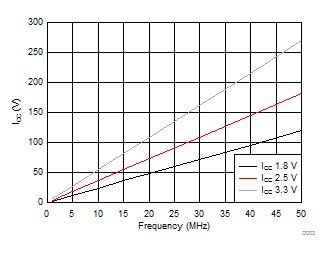SCAS757B December 2003 – September 2014 SN74LVCH16374A
PRODUCTION DATA.
- 1 Features
- 2 Applications
- 3 Simplified Schematic
- 4 Revision History
- 5 Pin Configuration and Functions
- 6 Specifications
- 7 Detailed Description
- 8 Application and Implementation
- 9 Power Supply Recommendations
- 10Layout
- 11Device and Documentation Support
- 12Mechanical, Packaging, and Orderable Information
パッケージ・オプション
メカニカル・データ(パッケージ|ピン)
サーマルパッド・メカニカル・データ
発注情報
8 Application and Implementation
NOTE
Information in the following applications sections is not part of the TI component specification, and TI does not warrant its accuracy or completeness. TI’s customers are responsible for determining suitability of components for their purposes. Customers should validate and test their design implementation to confirm system functionality.
8.1 Application Information
The SN74LVCH16374A device is a high-drive CMOS device that can be used for a multitude of bus-interface type applications where the data needs to be retained or latched. The SN74LVCH16374A device can produce 24 mA of drive current at 3.3 V; thus, making it ideal for driving multiple outputs and appropriate for high-speed applications up to 150 MHz. The inputs are 5.5-V tolerant allowing it to translate down to VCC. The Ioff feature allows voltages on the inputs and outputs when VCC is 0 V. The Bus Hold feature eliminates the need for external pull-up or pull-down resistors on unused or floating inputs.
8.2 Typical Application
 Figure 5. Typical Application Schematic
Figure 5. Typical Application Schematic
8.2.1 Design Requirements
This device uses CMOS technology and has balanced output drive. Care should be taken to avoid bus contention because it can drive currents that would exceed maximum limits. The high drive will also create fast edges into light loads, so routing and load conditions should be considered to prevent ringing.
8.2.2 Detailed Design Procedure
- Recommended input conditions
- Rise time and fall time specs: See (Δt/ΔV) in the Recommended Operating Conditions table.
- Specified High and low levels: See (VIH and VIL) in the Recommended Operating Conditions table.
- Inputs are overvoltage tolerant allowing them to go as high as 5.5 V at any valid VCC.
- Recommend output conditions
- Load currents should not exceed 50 mA per output and 100 mA total for the part.
- Outputs should not be pulled above VCC.
8.2.3 Application Curves
 Figure 6. ICC vs Frequency
Figure 6. ICC vs Frequency